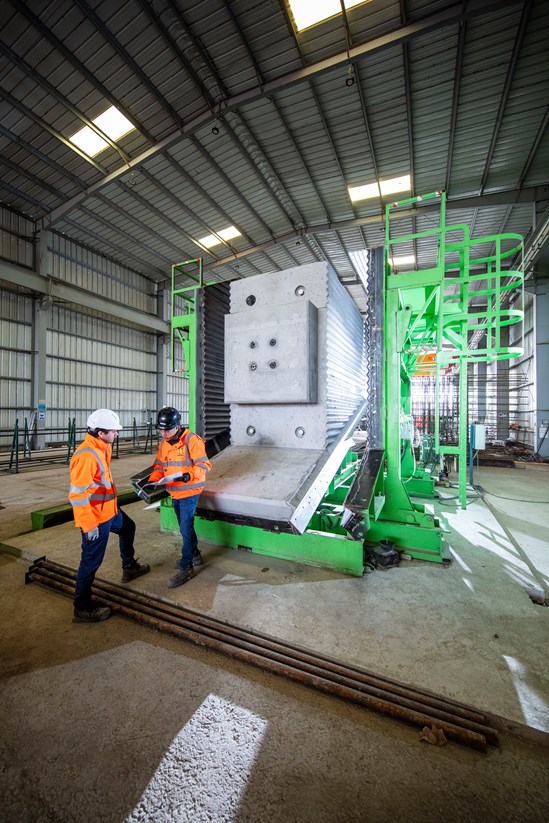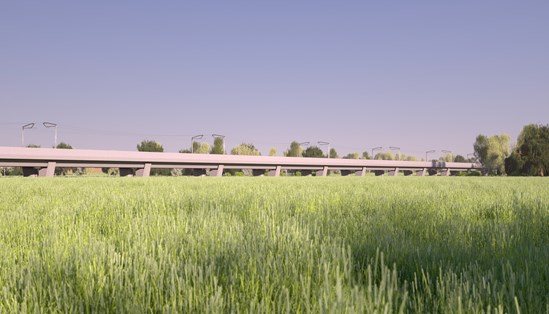Construction of HS2’s pioneering Thame Valley Viaduct has now passed the halfway point, with 44 out of 72 customised pre-cast beams in position, 66 of the 70 piers installed and work well underway on the deck that will support the railway.
The viaduct near Aylesbury is one of the longest on the high-speed rail project and a UK-first in terms of the amount of the structure which is being manufactured off-site.
Instead of using a more traditional approach, with multiple narrower beams for each span, the design team opted for a simple structural solution with just two larger hollow 20 or 25m u-shaped beams per span.
These, alongside deck slabs, parapets and all but two of the piers, are being manufactured almost 85 miles away, at a factory on the Isle of Grain, in Kent.
The simple design, inspired by viaducts on the Spanish high speed rail network, allows the beams to be secured end-to-end without concrete being poured on site. It also reduces the amount of carbon-intensive concrete and steel in the structure – cutting its carbon footprint by around a third.
Crossing the flood plain of the River Thame, the 880m long viaduct will carry HS2 services between London and Birmingham – dramatically improving journeys while freeing up space for more freight and local services on the existing network.
Set low into the landscape with a purposefully simple and consistent profile, the underside of the viaduct will be just 3m above the ground, with 36 even spans crossing the river and surrounding flood plain.
As well as cutting embedded carbon, the pre-fabricated approach also requires fewer lorries to deliver material to site, simplifies construction, cuts waste and reduces disruption for the community during construction. Safety on site is also improved by reducing the amount of work at height.
Ben Sebastian-Green, HS2 Ltd’s Senior Project Manager said:
“Thame Valley is one of the longest – and from an engineering perspective, one of the most interesting - structures on the project and it’s been great to see so much progress over the last six months.
“The post-tensioned double-beam approach used here has enabled more of the viaduct to be manufactured off-site - dramatically improving efficiency, safety and quality while delivering outstanding performance and durability.”
The viaduct was designed by HS2 Ltd’s main works contractor, EKFB - a team made up of Eiffage, Kier, Ferrovial Construction and BAM Nuttall - working with specialist on-site construction partner, FC Civils Solutions.
Following the success of the design, a similar approach is now also being used for the nearby Edgcote Viaduct in Northamptonshire.
Traditionally, viaduct beams – even when manufactured off-site - are secured together above each of the piers with a concrete ‘diaphragm’ which is cast in situ. The larger pre-cast beams used at Thame Valley and Edgcote can be secured directly to one another, removing the need for the diaphragm.
This also speeds up work on site, with up to six 90 tonne beams installed every week during the first 6 months of assembly. Deliveries from the PACADAR UK factory in Kent arrive overnight with the beams installed early in the morning.
On average it takes a team of 10 people around three hours to install one beam. Careful planning and quick installation is especially important at Thame Valley because of the very long, narrow layout of the site.
Once the beams are in place, specialist teams can begin threading steel bars between the beams which are then post-tensioned to ‘lock’ them together and give the viaduct the structural strength needed to support trains travelling at speeds of up to 225mph.
Emma Bolado-Arroyo, EKFB’s Project Manager, said:
“We’re at a crucial and exciting stage with the construction of this innovative viaduct, with beams, piers, post tensioning and pre-cast slabs under construction. This incredible progress is a testament to the hard work and drive of our expert teams. We’re all very excited to see this structure being delivered safely and to programme.”
The viaduct beams and 68 giant concrete piers – each weighing 42 tonnes – were all cast at PACADAR UK’s factory on the Isle of Grain, alongside the parapets and concrete planks that form the deck on top of the beams will carry the track.
Off-site manufacturing also helps spread contract opportunities and supply chain jobs across the UK, with 200 people - including apprentices and graduate engineers from nearby Universities - employed on the Isle of Grain, delivering the viaduct and also making tunnel segments for HS2’s London tunnels.








